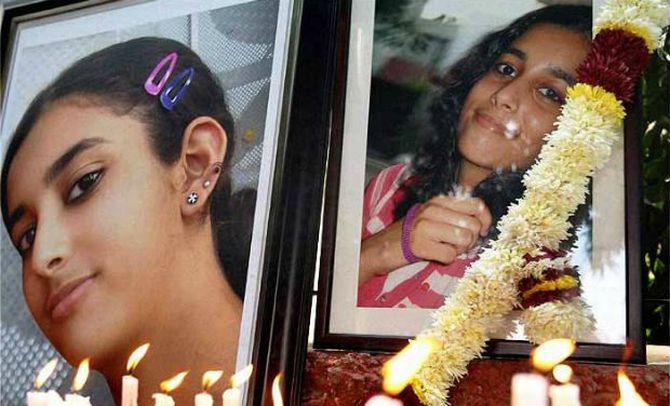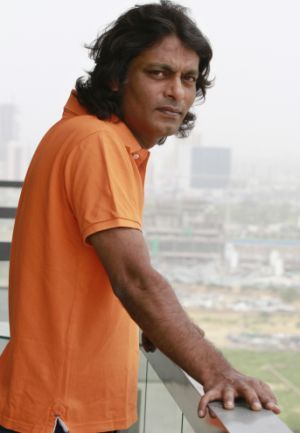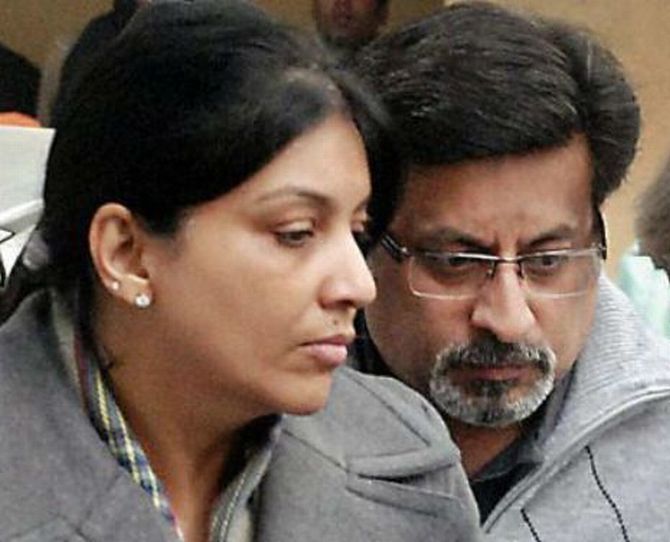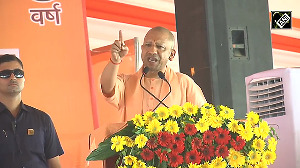'If the State does want to come after you, in India, it can do pretty much anything. And often it isn't as though the orders are coming from the President or prime minister, no, the systems have been built in a way -- or we have allowed them to be built in a way -- that almost encourages crushing of liberties.'
'Ekta Kapoor understands things a lot better than anybody else. Absolutely a genius... She tapped into this quite early: That post liberalisation there is a relatively moneyed and large middle class which actually thinks in a very kind of saas-bahu way.'
Avirook Sen speaks to Vaihayasi P Daniel/Rediff.com about his book Aarushi, and the murder trial that transfixed India.

Four people -- including a 13-year-old child with a shining face and glowing eyes that shall never sparkle again -- paid with their lives for a repugnant crime that took place in a middle-class locality in Noida, outside New Delhi, in 2008.
As a nation, we firmly believed justice had been served to two people, when an Uttar Pradesh court pronounced its lengthy judgment, November 25, 2012.
Sadly, we did not realise that perhaps the toll went up further.
And maybe four lives were taken after all.
It took journalist Avirook Sen three long years to painstakingly and meticulously piece together an eye-opening account of the justice that was probably deprived to all four, when he wrote Aarushi, published a few weeks ago by Penguin India.
Sen's cautious reconstruction of the murder, investigation and trial takes us back seven years to the night when Aarushi Talwar and Hemraj Banjade's lives were abruptly taken from them.
It reminds us of the fact that the judgment -- apart from finding her parents guilty -- slashed the memory and character of the 13 year old and a trusted house servant. In death neither got a chance to defend themselves.
Sen's book also delivers an uncomfortable judgment on the Central Bureau of Investigation, the judicial system, the media and, really, all of us out there who did not doubt a verdict that may have been faulty.
Aarushi is finally a book about India. It shows up the inadequacies of our wretched system. It puts on display some of the worst sides of India: India at its most illogically inefficient. India at its most shockingly unjust and apathetic. India at its most awkwardly comical. Yes, there is plenty of black comedy in play in Sen's book.
Even if you doubt the premise of the book -- that the dentist couple Rajesh and Nupur Talwar were never guilty of murdering their child -- it is important to read Aarushi to understand how tentatively an investigation actually unfolds and just how powerful the police is in India.
Sen, who covered the trial for the Mumbai Mirror newspaper and sify.com, has backed up his reporting with court documents, investigation reports, court testimonies and interviews from people on all sides of the case, including the judge. It is a book where the Talwars' story/voices are mostly heard through others.
The reporter does not offer conclusive evidence about who committed the murders and was unable to interview those who might have. Rather, he seeks to show, convincingly, that the Talwars did not and open up the possibilities that it was probably someone else.
And he lays bare what may be a miscarriage of justice.
A miscarriage so bewilderingly large for two people who pitifully drag through their days at the Dasna jail, near Ghaziabad, remembering more than anything else their daughter much loved and lost.
Sample this extract from Rajesh Talwar's prison diary: 'Miss Aaru (Aarushi) so much and that time and our life. People talk about their children and what they are doing. They come and meet them in jail. But for us, nothing... Met Nupur in the afternoon. It's really strange what life has dealt us. But this is what it is. Just thank God for what he is giving us in this situation.'
Aarushi Talwar would have been 21 this year.
 Can Avirook Sen, image, left, set some wrongs right with his book? Is there something dramatic that can happen to see that justice is served, assuming it was not?
Can Avirook Sen, image, left, set some wrongs right with his book? Is there something dramatic that can happen to see that justice is served, assuming it was not?
Says Sen, "The appeal process is on. In certain cases, which are -- I wouldn't say exceptional, but unusual -- if new evidence or new material comes to light post a conviction, then you can apply to the same honourable court. Since there is new material in this book, which goes beyond the investigation, material that was suppressed, for instance, and material that was not known, I believe the Talwars will be approaching the Allahabad high court to see whether they can include this in their appeal."
For the Talwars, who recently celebrated their 25th wedding anniversary in prison (they met while studying dentistry at the Maulana Azad Medical College, Delhi; he the son of a surgeon, she from a military family), his book is a cautious "ray of hope," says Sen.
"They see hope more than anything else in this book -- the hope that it changes perceptions and minds."
At the same time the book was a painful read for the couple, who are lodged in different wings of the Dasna jail, the same prison where the Nithari killers are imprisoned, severely overcrowded, with approximately 4,000 plus inmates.
"It is at once upsetting for them because of the graphic nature of the book. It makes them re-live a number of things, which they filed away in memory, somewhere, but wouldn't often revisit."
The Allahabad high court has a huge backlog of cases (as per late last year's figures, from a PTI report, 347,967 criminal cases are pending in the court) and the high court is hearing appeals pending since the 1980s.
In spite of that, it is likely there will not be an interminable wait for the Talwars' appeal to come up in court, says Sen. This is because in March or April last year, considering the facts of the case, a judge ordered the appeal to be fast tracked. The Talwars' lawyers have started up this process and there should be some movement this month.
How did Aarushi come to be more than just a juicy murder mystery? How did it become also a book about India?
A book that makes evident the immeasurable divides that clumsily coexist between different Indias, as it transparently shows how little understanding much of the establishment -- be they judges, policemen, forensic experts -- had of a bubbly teenager like Aarushi, with a hectic, harmless, social life, on and off the Internet. Or the life of the Talwars, who supposedly belonged to the privileged upper middle class and therefore alleged to be capable of playing couple-swapping games as of murdering their child with surgical instruments to save their honour.
Sen says he believes strongly in reporting on the background of a story and bringing in the context and to focus less on the adjectives and more on the verbs.
Says Sen, "Manu Joseph, in a Hindustan Times column (discussing Sen's book), said it has 'a series of India moments.' I think that is bang on. Things (like the trial) didn't happen in a vacuum. There is context and characters around it. As a reporter, I think, it is very important to report that. To observe it. To keep your eyes and ears open. And describe it as best you can."
"This (concept of many Indias) is not something terribly new," says Sen. "We all intuitively knew this: India has many faces. There is one story which is put out. That India is a progressive democracy, high growth and all of that... But India is a mosaic of many other things... The point of this book is to recognise that there are many, many aspects. These are usually spoken about in quiet, abstract terms. India has many faces. Sure it does. Or there are two Indias or three Indias -- choose your number!"
"But what this book does is, it takes this abstraction and makes it real. Or connects it to reality -- actually describes these Indias. Rather than saying this India is different from the other and leaving it there. Or, talking about class or caste, or whatever it is, and just leaving it there. It describes the actions of all these Indias, at work... shows how these Indias work."
The divides that became evident, between those processing the Aarushi case and the victims, for Sen, was not a matter of surprise. Nor even that at times, feudal attitudes -- that quickly, illogically label people as 'loose' or of 'poor character' -- in India, can strongly prevail.
"I am not a social scientist, so I can't theorise about it. I am really not qualified to do that. What I can do -- once again -- is to describe how these things work, as I tried to do that in the book, and let the reader make up his or her mind... on how big a part these attitudes play, in a situation where you are opposing/or pitted against the State."
"I can tell you this, that if the State does want to come after you, in India, it can do pretty much anything. And often it isn't as though the orders are coming from the President or the prime minister, no, the systems have been built in a way -- or we have allowed them to be built in a way -- that almost encourages crushing of liberties. As middle class people we are deeply conservative, in our attitudes towards institutions, the judiciary, the army..."
He goes on to declare that the most accurate Indian sociologist, or decipherer of pan-India attitudes, is television producer Ekta Kapoor, who he interviewed for the book, and whose viewpoint he later decided to not include.
"Ekta Kapoor understands things a lot better than anybody else. Absolutely a genius... She tapped into this quite early: That post liberalisation there is a relatively moneyed and large middle class which actually thinks in a very kind of saas-bahu way."
When Sen met Ekta Kapoor in 2013 she asked him about details of the 'affair' between Aarushi and Hemraj, and was surprised to be told that the post-mortem report showed no evidence of sex, but she added, which Sen wrote in an article for scroll.in: 'Well, who really knows what happens in these debauched households...'
Covering The State of UP through the CBI vs Rajesh Talwar & Another case, between May and November 2012, as it unfolded at the court in Ghaziabad, for sify.com and Mumbai Mirror, while not exactly an ordeal or that shocking for Sen, was still tough work emotionally.
As he describes in his book, Ghaziabad's haphazard courtrooms, sorely lacked any feeling of judicial majesty and were chaotic, dirty and hot. The court proceedings too were dismaying to watch and hear, because they seemed, he observed, imbalanced and indifferent.
"What I like to do in any situation is observe, which is what happened here. The other thing is, that while you are reporting something that is traumatic and grim, to take you through that moment, or situation, it is best to observe the moments that are utterly comic. And I really enjoy reporting those moments because they offer relief."
"In this case, on a daily basis, the court, the premises (in Ghaziabad) -- I knew what was going on inside there was pretty grim -- reporting on the dark humour of it, offer relief. There is something about it, which was very compelling to watch at work."
Right from the beginning, as the investigations proceeded in this double murder case, the Talwars seemed to receive not much sympathy, or belief, from the public. It was a case that India talked about a lot and often in sentences where the case was invariably prefixed with the word 'sensational.' The Talwar family, home, reputation and life were trashed many multiple times on primetime television between 2008 and 2012.
It is not particularly apparent why so many Indians gained such strong views about the case. But as scroll.in editor Naresh Fernandes recently tweeted: 'Yakub Memon and Teesta Setalvad prove that India gets outraged only by one side of the story.' The same seemed so for the Talwars.
Why did people so easily believe the Talwars, image, below, were guilty?
Was it because we tend to judge real life through the lens of Bollywood and expect high emotions and filmi plots like honour killings and deaths with dental scapula to be plausible?
Why could no one believe that someone from outside might have gotten into Aarushi's bedroom and killed her?

"You listed in your previous questions all those institutions, right (the establishment, be they judges, policemen, forensic experts who were judgemental about Aarushi and the Talwars). I think you missed out one. The media," says Sen.
"What saddened me through this process was the paucity of questions. The lack of curiosity. Just the idea that: If I am receiving information from an official, then it must be true. Even if the official will remain unnamed. He builds a deniability into it any conversation I have with him. There is quite a lot of this. The lack of questioning of the line being presented by State players, in this case. This was a source of sadness to me. Because I have been a journalist all my life. It is something I used to wonder: So have we lost it completely? Is this really how we work? I had several moments of reflection about this."
"Once you have this kind of media, and this kind of story is put out, it becomes this vicious cycle. So the media in turn will influence all the players -- and I include everybody in this -- investigators, judiciary, everybody. They are not outside the influence of the media -- all of them. They pick up on that public mood as well and they act accordingly. Once they act accordingly, the media again picks it up: 'We were right all along.' This is cyclonic, really. This is what happened to the Talwars."
He adds, in the context of why no one believed any other version of the murder: "I think there is disbelief, because the story put out is the opposite story."
Sen, by contrast, slowly became certain that the Talwars were innocent. The bizarre events of the trial led him quite easily to that conclusion.
It was hard not to feel that way when, day after day, he witnessed the flaws, he alleged, in the slapdash, stop-start investigation, the crucially missed evidence, the quick, random conclusions, and, what he felt was, severely biased testimony by the prosecutor.
He believed that when the CBI finding itself short of clues, confessions (the backbone often apparently of many an Indian criminal case) and time -- and under pressure from the media because it was a high profile case -- took the easy way out and went after the only suspects left, the Talwars, since the others had been let off.
Sen studied the court and investigation documents, available in the public domain, and interviewed as many people as he could, relating to the case, to give the truth to his conclusions.
What finally made Sen sure the Talwars were innocent?
What were the most convincing pieces of evidence that exonerated the Talwars in his eyes?
"There were two documents which for me were very striking," he recalls. "One is document number 79, which is (the forensic scientist on the case) Dr M S Dahiya's crime scene reconstruction. The whole case is laid out in that document."
"What happens is that he starts out with a wrong premise. His premise is that Hemraj's DNA and blood were found in Aarushi's room. And Hemraj's pillow cover was found in Aarushi's room. That is a factual error. A really disastrous factual error."
"His story follows from there, from that premise. I found that shocking. That a forensic scientist would rely on a fact, and then make up the scene or this other theory/story, whatever you may call it. And that the investigators would make no efforts at all to let him know that: 'Look, sir, we have a problem here. This is not the case. The evidence does not say this.' But they made no effort to correct it. That's one document; shocking document."
"Second, this is probably even more shocking. There was a report from the CDFD, Hyderabad (Centre for DNA Fingerprinting and Diagnostics), of the possible direct involvement of someone else. I speak of Hemraj's blood being found on (Hemraj's friend, who lived nearby) Krishna's pillow cover, several houses away. So there is evidence on Krishna's bedding, there is Hemraj's blood and DNA. This is completely missed. It is an error of omission, by people we regard as the best investigators in the country."
"These two things were truly shocking in terms of the record. The other thing I was shocked by -- this is something else, it is a propriety issue. I was quite shocked with what the Allahabad high court judge told the Talwars, in open court, when the counsel pleaded that they are moral citizens, they don't have a record, and they won't repeat the crime."
"The judge told them that, well, they can't repeat the crime because they don't have another daughter to kill. That speaks of something other than what the Supreme Court calls the majesty of the court, of our judicial system. This is a high court. Not a small court. A high court of the most populous state in India, Uttar Pradesh. For millions of people that's their court. I was shocked by that."
In his book Sen goes to great length to unravel why Dr Dahiya and A G L Kaul (the chief CBI investigator) could construct such damaging testimony against the Talwars. He carefully unearthed details of their past cases, how they were solved and dug for information that would provide an insight into their efficiency, or lack of, while solving the Aarushi-Hemraj murder case.
The journalist collected a slew of small and large details, about their functioning, like, for instance, the fact that Kaul absurdly -- and in a gesture which Sen says shows lack of propriety and smacks of bullying -- decided to create a special e-mail ID (he already had a CBI official address) named hemraj.jalvayuvihar@gmail.com, which incorporated the name of the Talwars' residence building and the slain help, from where he specifically sent mails to the Talwars.
Or the fact that a post-mortem report was tabled in which the pathologist, who did Aarushi's autopsy, utilised the eye-witness account of two sanitation workers (sweepers), to verify if the cervix was dilated and actually visible.
In chronicling these methods, the sloppiness of police and CBI technique was unfavourably paraded. The book Aarushi therefore has perhaps done a competent job of exposing the workings of the CBI and the police. The inefficiencies. The lazy way in which investigations happen.
Right from the beginning there was little doubt that the Aarushi-Hemraj murder case -- with the shockingly delayed discovery of Hemraj's body -- was one of India's least competent police investigations to begin with. But Sen made sure his account was nothing short of damning when it came to the reputation of a certain section of the CBI.
Surprisingly, there have been no reactions from the CBI since the book released. Says Sen: "From the officials, what I have picked up is: That many of the players involved in this particular case are scattered and the establishment, as it is now, is not going to put themselves out to defending the players or attacking me or whatever. Slightly wary of doing that."
"The CBI is under pressure, already, in terms of its image. They are not enthusiastic about taking up a cause for ex-colleagues, which is what I have picked up... They could have easily said look this book is a pack of lies..."
"In building my point of view on the case -- it is my point of view, it is even my opinion really -- I have relied upon evidence, testimony, trial court records, documents. They overwhelmingly point in one direction. That is not something I have made up."
"What happened in that court points in one direction and that is the direction that this book has taken, based on that record -- and my initial reportage -- but primarily on records. Most of these things were actually public documents... Most of the book is based on public records, public documents. The evidence is stacked on one side, overwhelmingly."
"So why did this happen to the Talwars? The case is built on a couple of things. (On) the people in the case... So you have the investigator. You have the forensic scientist. Experts who are saying this (about the Talwars)."
"And you have a (the Ghaziabad) judge who could not recall for me, in my interview with him, one person who he has acquitted. Not one man. You have this trident of individuals... You place the Talwars in that context, you can see for yourself this was how it happened. No other outcome... Cheerleading all three people was the media. Once you set this momentum in motion, it moves on its own. Inexorable. You can't stop it."
Many of the Talwars' friends, like most of India's middle class, were afraid to testify in their favour or help. "(This is because) we would like a distance from anything is murky. Anything that has to do with the State being involved, with the police being involved..."
"But that comes out of a deep distrust for the State. We don't like dealing with the State. Look at yourself. How often do we deal with the State? I can think of only a couple of situations possibly where I have to deal with the State. One is when I apply for a passport, then I have to go and queue up. The other is on the road in traffic. Both are unpleasant experiences... Why is that people pass a dying man (hurt in a car accident) on the road? Because by picking him up and taking him to the police station will be just the beginning of your troubles."
Sen, 46, an independent journalist who lives in Gurgaon and has worked earlier at Sunday, India Today, News X, and as group editor, Mid-day, resident editor Hindustan Times, took three years, more than 1,000 days, out of his life to research and write Aarushi.
He says he did little else, utterly obsessed with getting each little detail nailed down, losing touch with friends and even the news.
When he started covering the court proceedings -- Mumbai Mirror Editor Meenal Baghel suggested he do so, because she said it would make a great narrative and Sen says "She's a brilliant story spotter" -- and he got "sucked in."
"The court itself was a character, and when the first CBI witness arrived it was a no-brainer: A must-do book."
But the point of writing the book, for him, was not so much to ensure that the Talwars somehow, hopefully, got justice. "What was important to me was to ask a few questions. I'm happy to wait for the answers. But till they come, I'll keep asking."
Sen is the first to say that Aarushi is not a perfect book, although he is very happy with the reviews. "They have been overwhelmingly positive. (Readers) are enthused by it; it has excited them. All the things that an author dreams of. This is backed by empirical data. It is number one on the non-fiction list -- in the only two lists that are out there, HT-Nielson and Financial Express -- within a week of coming out."
For him, a key shortcoming of the book has been his inability to speak to or not know anything further about Krishna, Rajkumar and Vijay Mandal, fellow Nepalis and friends of Hemraj (he hailed from Arghakhanchi, Nepal), who probably visited the Talwar home that night, leaving a reader of Aarushi with a bunch of unanswered questions and a touch of dissatisfaction.
Where are these men now?
Are they back in Nepal?
Could they be working somewhere in India perhaps?
Does the police have any information on them?
Sen says the shortage of information on Hemraj's friends is not for lack of trying. "Unless I can access a piece of information, I will not put it out in the book. In this case, I really don't know (where Krishna, Raj Kumar & Co could be). I have vague clues about this, which I cannot/could confirm... I had an idea where they are, but this is not something that is for certain. And therefore it is not in the book."
"It's also important to remember that the story of the other suspects played a very minor role in the trial -- and had no place at all in the prosecution's narrative. This was a murder trial: The focus on the people charged; guilty, or not guilty."
In the cast of characters in the case -- and in Sen's book -- which person stood out the most in this narrative, positively or negatively? "It's tough to pick one because they are all very interesting. But gun to my head, I'd say (retired Ghaziabad judge) Shyam Lal. Do I really need to explain why? Or is it enough to say that he is the most eloquent spokesman for what we quietly call 'India'?"
And in this 'India' is it quite clear that many of India's problems stem from a bad police system? "My view (in the book) may make a larger point. I hope it does. It really takes this case, which for me brings together all of these things. They all converge into this one case. You can at least illustrate, with examples from this case, all the points you raised. How we are as Indians. Our attitudes towards servants. How we deal with the State. All of these things, at the very least, can be illustrated by the events of this case. That's why it is important. That's why the book."
And a book that is about India, more than anything else.
"Yes. It is not just a juicy murder mystery. No."











 © 2025
© 2025